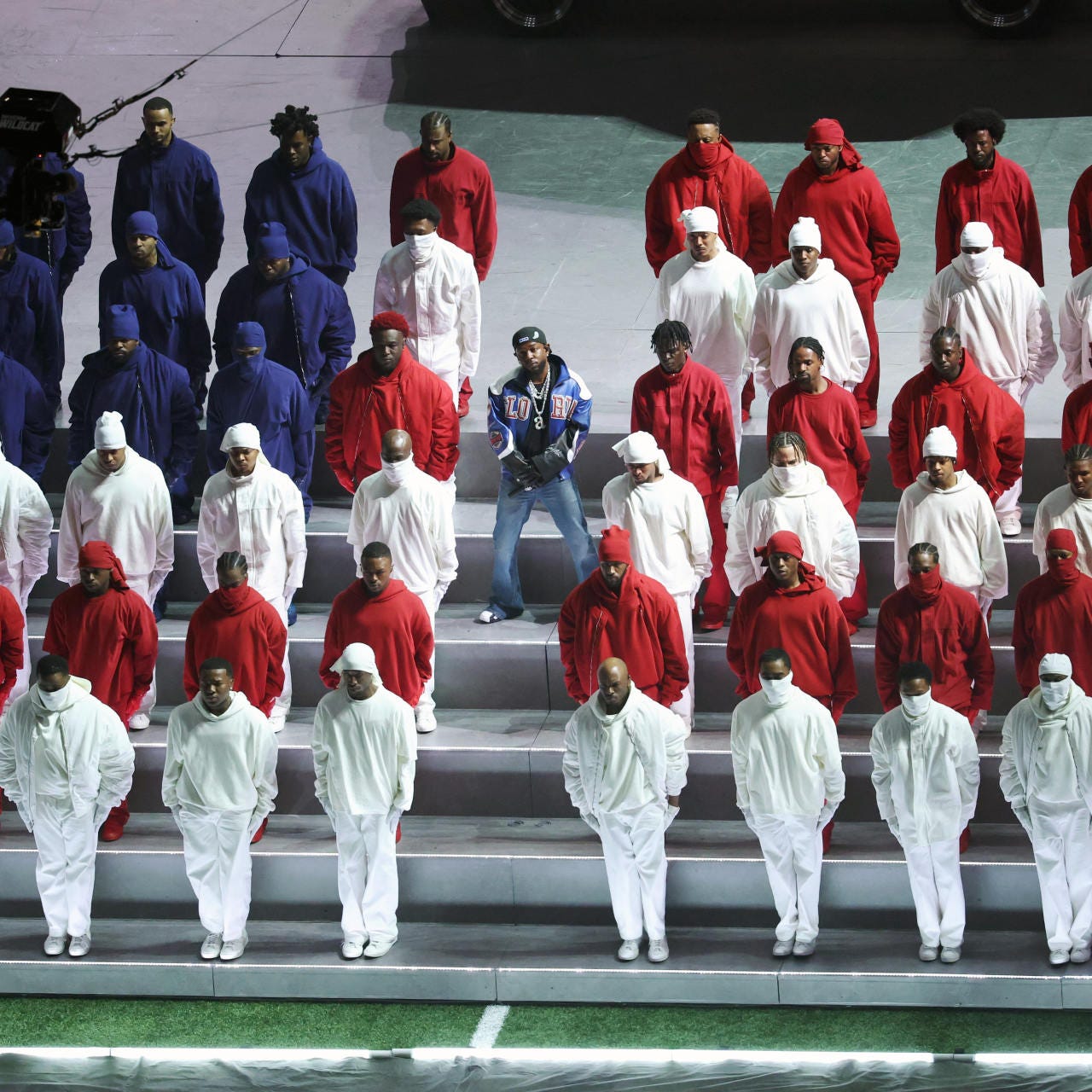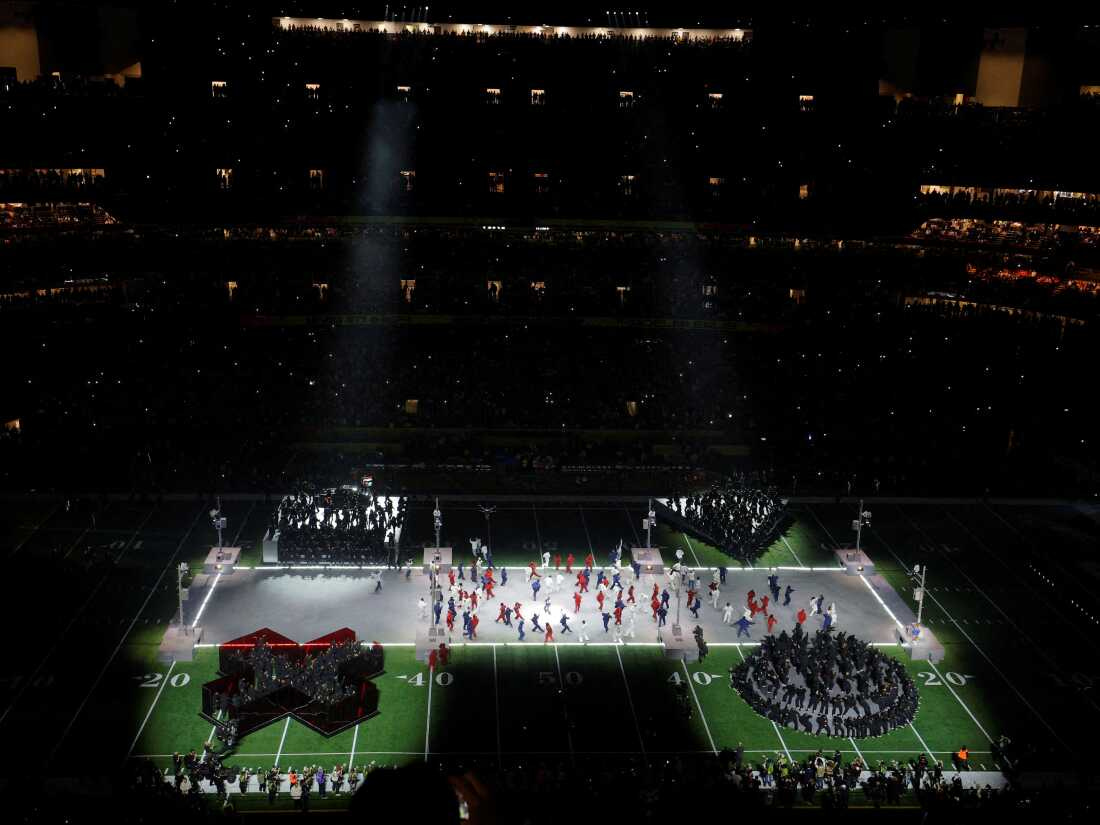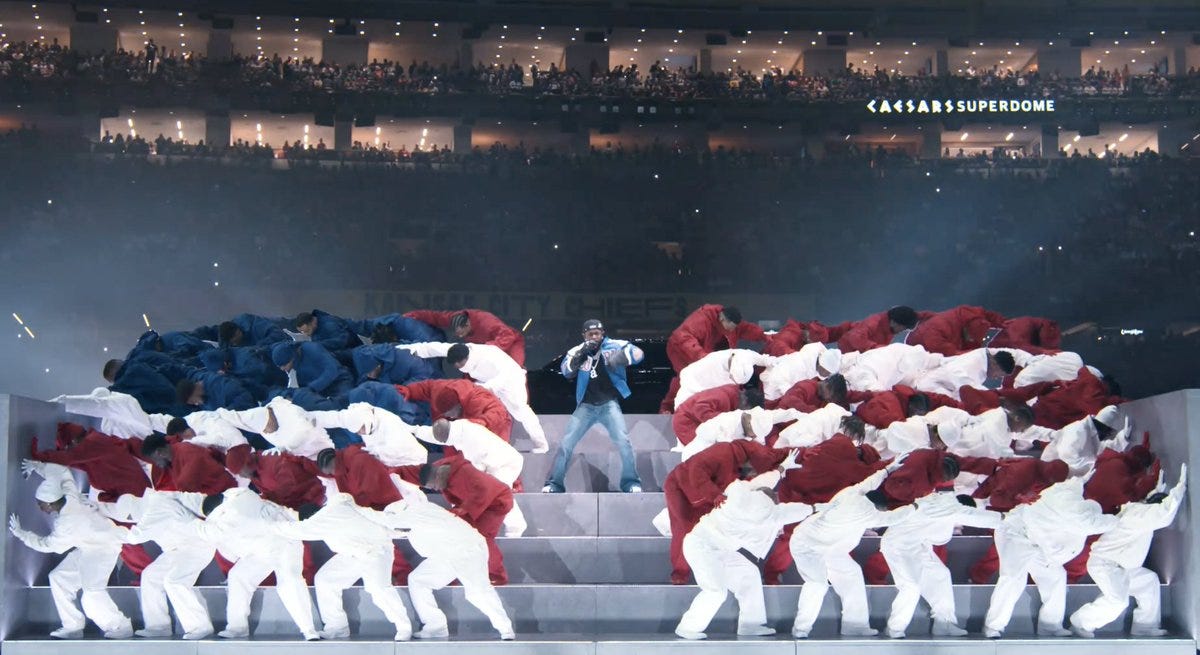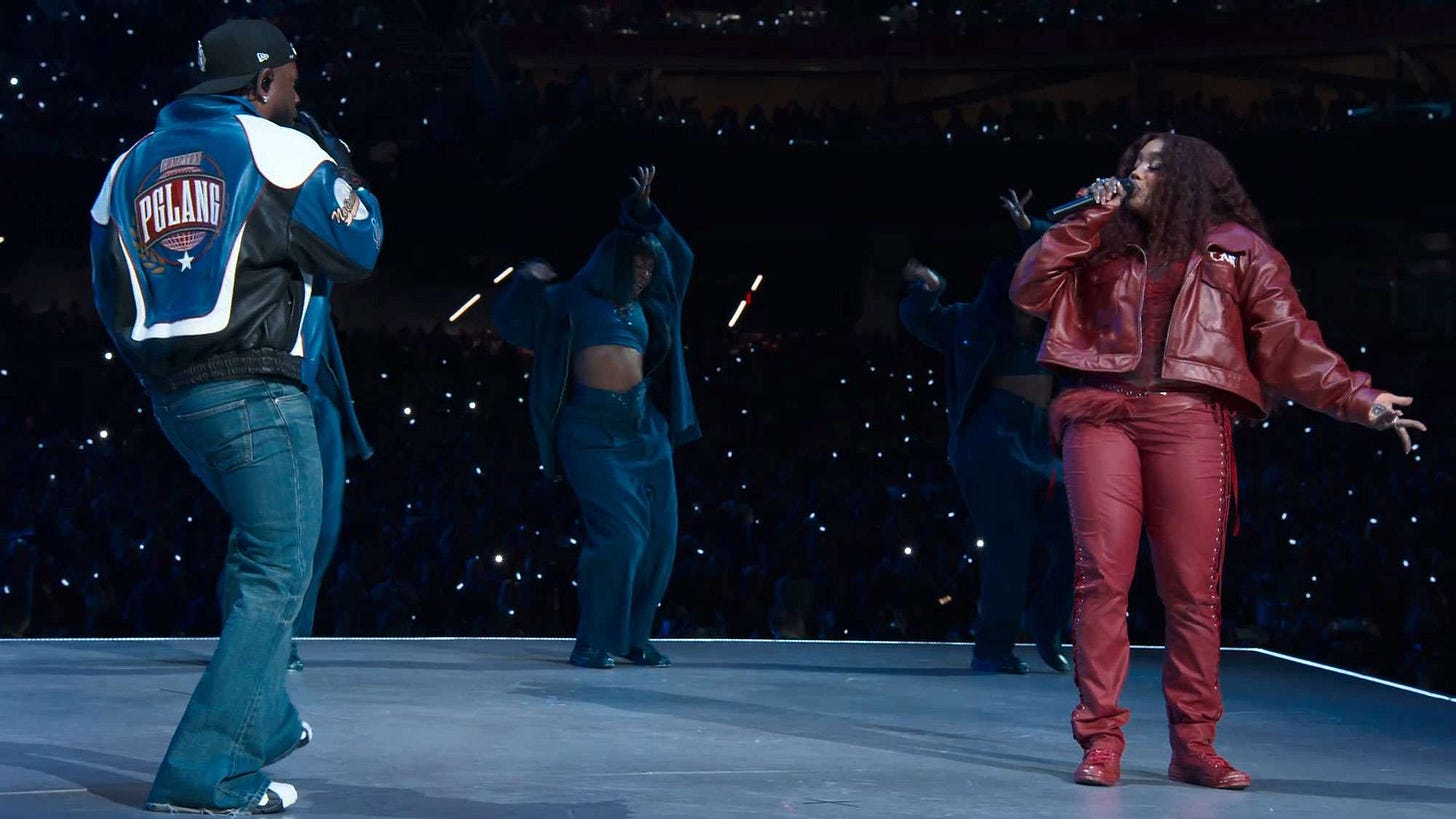Kendrick Lamar's Super Bowl Halftime Show: Concert Review
Performance art on the world's biggest stage
Super Bowl halftime shows are always a spectacle. Lady Gaga jumped from the sky and hung on a trapeze. Katy Perry rode in on a giant tiger. Michael Jackson popped out of the ground and stood still for two minutes to aura farm.
Kendrick Lamar’s set on Sunday was just as much of a performance, but in a different way. It has the high-budget and high-quality choreography we’ve come to expect from the Super Bowl, but elevates that to an entirely different echelon by pairing that production with an incredible message—both explicitly and subliminally.
Recap and Analysis
I think the biggest (and really only) critique I’ve heard about the show is its set list. It’s a little disappointing as a longtime Kendrick fan whose favorite album is his first major release that he didn’t perform any songs released before 2017. I honestly do agree with the criticism that Kendrick had the opportunity to celebrate his entire catalogue, but instead commercialized his performance to maximize the spotlight on his newer songs and capitalize off of the recent Drake beef. I see the motivation behind the move, and I don’t fault him at all for it—I wish he could have gone the opposite direction, but it’s understandable that he didn’t.
Let’s go through his performance, track by track. The first thing that becomes obvious is the video game-themed set, which I personally thought was a bit of an odd choice (also thought that it was Squid Game at first). Kendrick rarely references video games in his discography—it’s more something I’d expect from Babytron, not him. The PlayStation control icon set pieces were well-utilized though—dancers circling around the O as SZA performed “All The Stars,” “peekaboo” from inside the X, etc.
The first voice we hear in the show is not Kendrick’s, but Uncle Sam’s. This is the closest thing we have to a TPAB callback apart from the one throwaway “30 acres and mule” line right before “Not Like Us.” He’s played by Samuel L. Jackson as the physical embodiment of America, perhaps more specifically America’s general public viewing audience. Throughout the show, he represents many voices: censors, conservative parents, the establishment as a whole—and he’s the foil to Kendrick’s bold, norm-breaking performance.
This choice works great. Aside from using Uncle Sam as a stand-in for America, the idea that the Super Bowl also acts as the pinnacle of American entertainment provides a similar effect. That message is only augmented when people like Donald Trump show up to the halftime show only to hear Kendrick declare “the revolution televised, you picked the right time but the wrong guy.” (Side note: Many people thought that this statement is what prompted Trump to leave. I genuinely doubt he has enough comprehension ability to even understand that this was a shot at him. He probably just hates rap music.)
We see Kendrick perform an even lengthier version of the song with which he teased the release of GNX but did not actually include on the album, which is currently collectively known by the fanbase as “Bodies.” I think extending the snippet confirms my suspicion that GNX was merely an appetizer, and there is plenty more to come.
Then after Kendrick takes his shot at the President, we transition to “squabble up.” There’s so much noteworthy about this performance as there is with what follows it: the return of Samuel L. Jackson’s Uncle Sam character, who proclaims that the songs Kendrick has performed are “too ghetto,” among other things. It’s very poetic that at the same time he was going down this monologue, my Asian family in the background was rambling on about they didn’t think rap was “real music” and that they “couldn’t understand” anything (remind you of anything? “too loud, too reckless?”)
Uncle Sam then orders Kendrick to effectively lock in, which transitions to “HUMBLE.” This song is probably my favorite performance of the night. This is the point where the background dancers assume the formation of an American flag, then Kendrick splits that formation straight down the middle. It’s heavily symbolic.
This American motif carries through the entire rest of the show, where the backup dancers, wearing red, white, and blue, jumble and form up periodically as the songs transition. “DNA.” and “euphoria” follow “HUMBLE.” This is the section of the show where Kendrick shows his live ability at breath control, which I find quite impressive—I can’t rap many of these verses without running out of breath.
I do think it’s interesting that “euphoria” was performed without any of the hoohah that preceded “Not Like Us,” as well as being in the section right after Uncle Sam tells Kendrick to tighten up. These tracks don’t have too much to highlight, aside from them being great performances of iconic songs.
The next section is previewed by a small section of “man at the garden,” which immediately transitions to “peekaboo,” which reuses some of the quick panning camera work seen in the “Not Like Us” music video. This is also where Kendrick says “you know they love to sue,” referencing Drake’s recent legal action over the song “Not Like Us,” as well as the first fakeout of that song being played.
“luther,” where SZA is introduced, follows. SZA was the perfect guest for this halftime show, as not only do most of Kendrick’s biggest hits feature SZA, but SZA’s vocals on those songs somehow got better live than in the studio version, especially on “All the Stars,” where she sounded absolutely angelic.
The true main event of the show came right afterwards. Right after Uncle Sam’s final monologue, where he showcases his anger at the starting notes of “Not Like Us,” Kendrick performs the song that ended the beef to a stadium that roared “A minor!”
Then, “tv off,” with all its references to New Orleans and its very title finally made sense as the track with which Kendrick decided to close his performance, literally asking everyone watching at home to turn their televisions off as if he was the main event and not the Super Bowl itself. The performance closed as the camera panned out from the stage into the crowd with lights that read “GAME OVER.”
Review
The execution of this halftime show was near-flawless. The mixing hiccups that I initially insisted were there were likely the result of my TV (heh, I really guess I should turn my TV off.) The show was well-produced, masterfully choreographed, and perfectly fit the vibe of each of Kendrick’s songs.
But the main value of this Super Bowl show wasn’t in how good it looked. You can argue that in terms of pure visuals, this was not as impressive as Shakira and J. Lo’s, the Weeknd’s, and especially Katy Perry’s. But this was the first Super Bowl, and perhaps the first time on national television, that there has been this extent of artistic expression and most importantly dissent against a norm.
There were two main bold moves that Kendrick made which really stand out. First was to actually make such an obvious political expression and satirize America on America’s biggest night—having Samuel L. Jackson stand in as his caricature for the country and its viewing audience is something that I’m surprised the NFL and Fox actually let through its censors. The fact that he essentially mocked 1/2 of his viewing audience (the “this isn’t real music” half), many of whom became even more the butt of the joke when they tweeted out hate directly after the show, is crazy.
The other daring move (which I unfortunately think Kendrick passed off as a little more courageous than it actually was) was allowing “euphoria” and “Not Like Us” be part of the set list given all the censorship and now lawsuits against UMG by Drake. I think playing a song like “Not Like Us,” intended to be targeted at one man, on a regulated stage like the Super Bowl is a pretty new thing. Keep in mind, one song before “Not Like Us,” Kendrick was telling Drake to die. The countless fakeouts were a pretty good way to encapsulate how unprecedented this set list was.
Overall, the triple entendre with “Game Over” at the end is a beautiful representation of what the show was about and just how brilliant it was. It’s “Game Over” for Drake, who overwhelmingly lost the beef (this could also be a reference to how kids play a lot of video games and Drake, well, [similar to how Kendrick told Drake “you make music that pacify ‘em”]). It’s also “Game Over” in that Samuel L. Jackson introduces the show as the “Great American Game,” a game which Kendrick is determined not to follow. Of course, it’s also “Game Over” since Kendrick is treating himself as the main event, not the Super Bowl, and ordering viewers to all turn their TVs off.
Rating: 10/10









